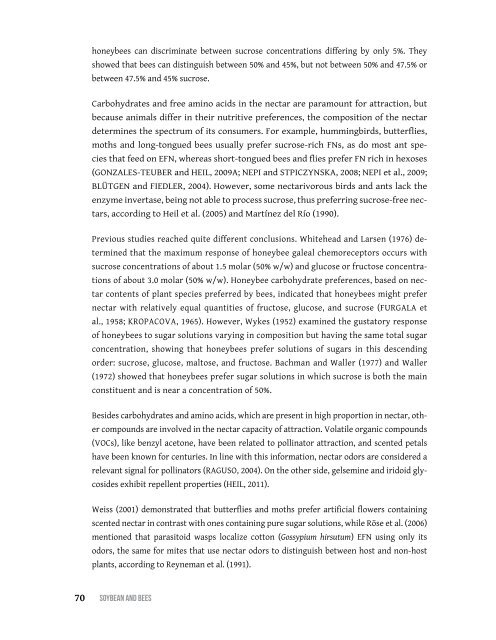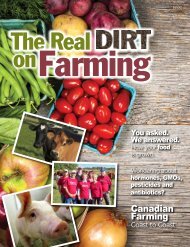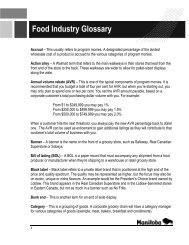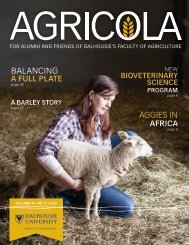SOYBEAN and BEES
BFhV4z
BFhV4z
You also want an ePaper? Increase the reach of your titles
YUMPU automatically turns print PDFs into web optimized ePapers that Google loves.
honeybees can discriminate between sucrose concentrations differing by only 5%. They<br />
showed that bees can distinguish between 50% <strong>and</strong> 45%, but not between 50% <strong>and</strong> 47.5% or<br />
between 47.5% <strong>and</strong> 45% sucrose.<br />
Carbohydrates <strong>and</strong> free amino acids in the nectar are paramount for attraction, but<br />
because animals differ in their nutritive preferences, the composition of the nectar<br />
determines the spectrum of its consumers. For example, hummingbirds, butterflies,<br />
moths <strong>and</strong> long-tongued bees usually prefer sucrose-rich FNs, as do most ant species<br />
that feed on EFN, whereas short-tongued bees <strong>and</strong> flies prefer FN rich in hexoses<br />
(Gonzales-Teuber <strong>and</strong> Heil, 2009a; Nepi <strong>and</strong> Stpiczynska, 2008; Nepi et al., 2009;<br />
Blütgen <strong>and</strong> Fiedler, 2004). However, some nectarivorous birds <strong>and</strong> ants lack the<br />
enzyme invertase, being not able to process sucrose, thus preferring sucrose-free nectars,<br />
according to Heil et al. (2005) <strong>and</strong> Martínez del Río (1990).<br />
Previous studies reached quite different conclusions. Whitehead <strong>and</strong> Larsen (1976) determined<br />
that the maximum response of honeybee galeal chemoreceptors occurs with<br />
sucrose concentrations of about 1.5 molar (50% w/w) <strong>and</strong> glucose or fructose concentrations<br />
of about 3.0 molar (50% w/w). Honeybee carbohydrate preferences, based on nectar<br />
contents of plant species preferred by bees, indicated that honeybees might prefer<br />
nectar with relatively equal quantities of fructose, glucose, <strong>and</strong> sucrose (Furgala et<br />
al., 1958; Kropacova, 1965). However, Wykes (1952) examined the gustatory response<br />
of honeybees to sugar solutions varying in composition but having the same total sugar<br />
concentration, showing that honeybees prefer solutions of sugars in this descending<br />
order: sucrose, glucose, maltose, <strong>and</strong> fructose. Bachman <strong>and</strong> Waller (1977) <strong>and</strong> Waller<br />
(1972) showed that honeybees prefer sugar solutions in which sucrose is both the main<br />
constituent <strong>and</strong> is near a concentration of 50%.<br />
Besides carbohydrates <strong>and</strong> amino acids, which are present in high proportion in nectar, other<br />
compounds are involved in the nectar capacity of attraction. Volatile organic compounds<br />
(VOCs), like benzyl acetone, have been related to pollinator attraction, <strong>and</strong> scented petals<br />
have been known for centuries. In line with this information, nectar odors are considered a<br />
relevant signal for pollinators (Raguso, 2004). On the other side, gelsemine <strong>and</strong> iridoid glycosides<br />
exhibit repellent properties (Heil, 2011).<br />
Weiss (2001) demonstrated that butterflies <strong>and</strong> moths prefer artificial flowers containing<br />
scented nectar in contrast with ones containing pure sugar solutions, while Röse et al. (2006)<br />
mentioned that parasitoid wasps localize cotton (Gossypium hirsutum) EFN using only its<br />
odors, the same for mites that use nectar odors to distinguish between host <strong>and</strong> non-host<br />
plants, according to Reyneman et al. (1991).<br />
70 SoybeAn <strong>and</strong> bees






